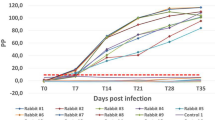Summary
Antigens and corresponding sera were collected from travellers with leishmaniasis returning to Germany from different endemic areas of the old world. The antigenicity of theseLeishmania strains, which were maintained in Syrian hamsters, was compared by indirect immunofluorescence (IFAT). Antigenicity was demonstrated by antibody titres in 18 sera from 11 patients. The amastogotic stages of nine strains ofLeishmania donovani and four strains ofLeishmania tropica were compared with each other and with the culture forms of insect flagellates (Strigomonas oncopelti andLeptomonas ctenocephali). Eighteen sera from 11 patients were available for antibody determination with these antigens. The maximal antibody titres in a single serum varied considerably depending on which antigen was used for the test. High antibody levels could only be maintained whenLeishmania donovani was employed as the antigen, but considerable differences also occurred between the different strains of this species. The other antigens were weaker. No differences in antigenicity between amastigotes and promastigotes of the same strain were observed. It is important to select suitable antigens. Low titres may be of doubtful specificity and are a poor baseline for the fall in titre which is an essential index of effective treatment.
Zusammenfassung
Wir sammelten Parasiten und Seren von Reisenden, die aus verschiedenen endemischen Gebieten der Alten Welt mit einer Leishmaniasis nach Deutschland zurückkehrten. Die Antigenaktivitäten der isolierten und fortlaufend in Goldhamstern gehaltenenLeishmania-Stämme wurden im indirekten Immunofluoreszenztest (IFAT) verglichen. Die Antigenität wurde an Hand von Antikörpertitern in 18 Serumproben von 11 Patienten bewiesen. Neun Stämme desLeishmania donovani-Komplexes und vierLeishmania tropica-Isolate wurden in ihrem amastigoten Stadium miteinander verglichen. Hinzu kamen zwei Insekten-Flagellaten als Kulturformen:Strigomonas oncopelti undLeptomonas ctenocephali. 18 Serumproben von 11 Patienten standen für die Antikörperbestimmung mit diesen Antigenen zur Verfügung. Die maximalen Titerhöhen variierten in ein- und derselben antiserumprobe zum Teil erheblich, je nachdem, welches Antigen für den Test benutzt wurde. Hohe Antikörpertiter konnten nur erhalten werden, wennLeishmania donovani als Antigen vorlag, es ergaben sich aber auch zwischen den einzelnen Stämmen dieser Leishmaniaart erhebliche Unterschiede in der Antigenaktivität. Antigene anderer Art erwiesen sich als wenig wirksam. Zwischen amastigoten und promastigoten Entwicklungsformen einesLeishmania donovani-Stammes konnten keine Unterschiede in der Antigenaktivität erkannt werden. Für den Nachweis möglichst hoher Antikörpertiter im IFAT ist die Auswahl geeigneter Antigene von ausschlaggebender Bedeutung. Niedrige Titer erschweren deren Beurteilung als spezifisch und sind eine schlechte Ausgangsposition für die Beobachtung des obligatorischen Titerabfalles nach erfolgreicher Therapie.
Similar content being viewed by others
Literature
Krampitz, H. E. Acht Jahrzehnte Leishmania-Forschung — offene Fragen im Blickpunkt der öffentlichen Gesundheitspflege. Bundesgesundheitsblatt 22 (1979) 461–466.
Krampitz, H. E. Trypanosomiasis- und Leishmaniasisimport. In:Gsell, O. (ed.): Importierte Infektionskrankheiten, Epidemiologie und Therapie. Thieme, Stuttgart, New York 1980, S. 42–48.
Falkner v. Sonnenburg, F., Krampitz, H. E., Löscher, Th., Prüfer, L., Weiland, G. The diagnosis of visceral leishmaniasis. Münch. Med. Wschr. 12 (1979) 1353–1356.
Bray, R. S. Leishmaniasis. In:Houba, V. (ed.): Immunological investigation of tropical parasitic diseases. Churchill Livingstone, Edinburgh, London, New York 1980, pp. 65–74.
Mannweiler, E., Lederer, I., zum Felde, I. Das Antikörperbild bei Patienten mit Leishmaniosen. Zbl. Bakter. I. Orig. A 240 (1978) 397–402.
Piekarski, G., Saathoff, M., Nekouri, M. H. Untersuchungen zum Nachweis von Leishmania-Antikörpern bei Kala-azar-Patienten und experimentell mitL. donovani infizierten Tieren. Z. Tropenmed. Parasitol. 24 (1973) 161–173.
Endrissian, Gh. H., Darabian, P., Zovien, Z., Zeyedi-Rashti, M. A., Nadim, A. Application of the indirect fluorescent antibody test in the serodiagnosis of cutaneous and visceral leishmaniasis in Iran. Ann. Trop. Med. Parasitol. 75 (1981) 19–24.
Aljeboori, T. I. A simple diphasic medium lacking whole blood for culturingLeishmania. Trans. R. Soc. Trop. Med. Hyg. 73 (1979) 117.
Hedge, E. C., Moody, A. H., Ridley, D.-S. An easily culturedCrithidia sp. as antigen for immunofluorescence for kala-azar. Trans. R. Soc. Trop. Med. Hyg. 72 (1978) 445.
Lopez-Brea, M. Diagnosis and serologic follow-up in three patients with visceral leishmaniasis usingCrithidia sp. as antigen. Trans. R. Soc. Trop. Med. Hyg. 74 (1980) 284.
Ranque, J., Dunan S. Comportement antigénique de divers flagellés au cours des leishmanioses cliniques et expérimentales. Ann. Parasitol. 39 (1964) 117–130.
Bray, R. S. Immunediagnosis of leishmaniasis. In:Cohen, S., Sadun, E. H. (eds.): Immunology of parasitic infections. Blackwell Scientific Publications, Oxford 1976, pp. 65–76.
Shaw, J. J., Lainson, R. Simply prepared amastigote leishmanial antigen for use in indirect fluorescent antibody test for Leishmaniasis. J. Parasitol. 63 (1977) 384–385.
Zuckermann, A. Current status of the immunology of blood and tissue protozoa. I.Leishmania. Exp. Parasitol. 38 (1975) 370–400.
Dwyer, D. M.: Amastigote and promastigote stages ofLeishmania donovani. An immunologic and immunochemical comparison. Prog. Protozool. Univ. de Clermont (1973) 129.
Bray, R. S., Lainson, R. The immunology of Leishmaniasis. I. Fluorescent antibody staining techniques. Trans. R. Soc. Trop. Med. Hyg. 59 (1965) 534–544.
Beforouz, N., Rezai, H. R., Gettner, S. Application of immunofluorescence for the detection of antibody inLeishmania infections. Ann. Trop. Med. Parasitol. 70 (1976) 293–301.
Rezai, H. R., Beforouz, N., Gettner, S.: Antibodies in cutaneous leishmaniasis. Proceedings. III. International Congress of Parasitology. Munich I, 1974, p. 252.
Author information
Authors and Affiliations
Rights and permissions
About this article
Cite this article
Krampitz, H.E., Löscher, T., Prüfer, L. et al. Evaluation of antigens for the serodiagnosis of kala-azar and oriental sores by means of the indirect immunofluorescence antibody test (IFAT). Infection 9, 264–267 (1981). https://doi.org/10.1007/BF01640988
Received:
Issue Date:
DOI: https://doi.org/10.1007/BF01640988




